Fans, especially ceiling fans, are an excellent option to improve ventilation and comfort at home or in work spaces. However, in order for them to work optimally and prolong their useful life, it is essential to keep them clean.
Basic tips on fan cleaning
Here are some basic tips for the maintenance and cleaning of a fan.
Ideal frequency for cleaning ceiling fans
How often do you clean your fan? If your answer is “when I remember”, don’t worry, you are not alone. But the truth is that you should do it at least once a month.
The reason is simple: dust accumulates quickly on the blades, especially in environments where there is constant air circulation or open windows. This not only affects the efficiency of the fan, but can also spread dust mites, pollen and other particles throughout the room.
If you live in an urban area with a lot of pollution or have pets, cleaning should be as often as every two weeks. On the other hand, if the fan is rarely used or is in a sporadically used room, you can space it out to every two months, but never more.
Quick fan cleaning routine
Here’s a little routine you can follow to keep your fan always in tip-top shape:
- Unplug the fan: for safety’s sake, the first thing you should do is turn it off.
- Surface cleaning: use a microfiber duster to remove visible dust.
- Blades: wipe them with a damp cloth with a mild mixture of water and vinegar.
- Motor and housing: with a soft bristle brush or paintbrush, remove dust without disassembling anything.
- Drying: always dry the blades thoroughly to avoid moisture build-up.
Recommended products

In Stock, delivery in 15-20 days
310.99 £
Ceiling Fan Phuket White 132cm AC Motor LEDS-C4 30-4398-16-16
View product
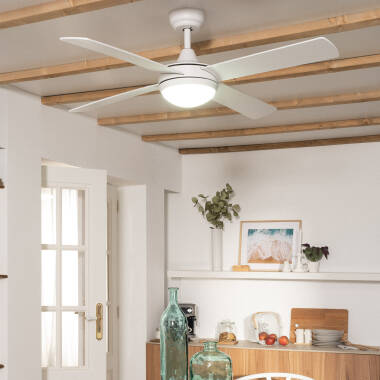
In Stock, delivery in 24/48h
90.99 £
Navy Silent Ceiling Fan with DC Motor 132cm
View product

In Stock, delivery in 24/48h
143.99 £
Weimar Silent Ceiling Fan with DC Motor for Outdoors in White 132cm
View product
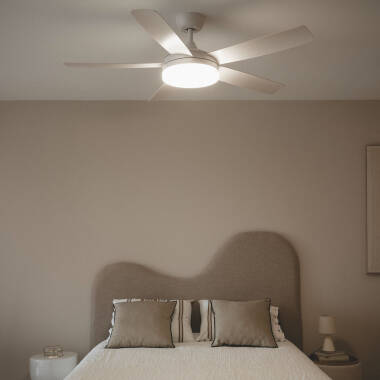
In Stock, delivery in 24/48h
90.99 £
Patroclo Silent Ceiling Fan with DC Motor in White 132cm
View product
Importance of fan cleaning for allergy sufferers
For those who suffer from allergies to dust, mold or dust mites, a dirty fan can become the worst enemy. This is because the blades, as they spin, spread the accumulated allergens in all directions, causing symptoms to intensify.
A tip for allergy sufferers is to use a damp microfiber cloth, as it traps dust without stirring it up. You can also use a face mask during cleaning, especially if the fan is very dirty.
Common mistakes when cleaning ceiling fans and how to avoid them
One of the most common mistakes is not unplugging the fan before you start cleaning it. It seems obvious, but many people forget this step and can suffer small electrical accidents or blows with the blades if it is accidentally activated.
Another common mistake is to use abrasive products, such as cleaners with ammonia or bleach, which can damage the finish of the blades, especially if they are made of wood or have a metal coating.
It is also common to clean only the visible parts, leaving dust accumulated on top of the blades or inside the motor, which affects the performance of the appliance.
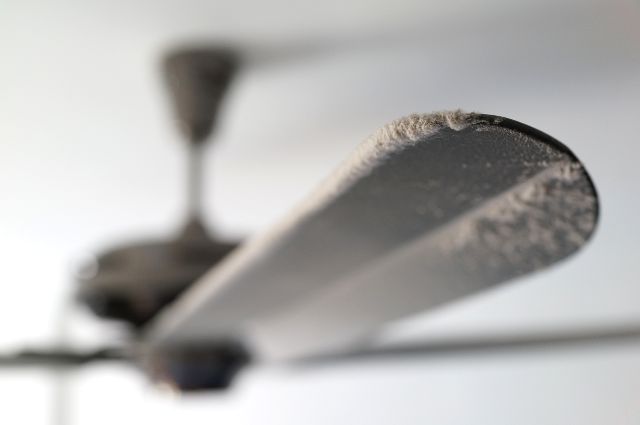
Also avoid using unstable ladders. Be sure to use a firm and stable base that allows you to reach all parts of the fan without risk.
Methods, products and tools for cleaning fans
Discover the essential cleaning products and tools, both purchased and homemade.
Home methods to clean ceiling fans effectively
The great thing about cleaning fans is that you can do it without spending a lot of money. Homemade methods are just as effective as commercial products, and much cheaper. A very effective recipe consists of mixing the following ingredients:
- 1 cup warm water
- 1/2 cup of white vinegar
- 1 tablespoon of sodium bicarbonate of soda
Put this mixture in a spray bottle and apply it directly on a microfiber cloth. Then wipe each blade with gentle movements. The vinegar acts as a natural disinfectant and eliminates odors, while the baking soda helps remove grease or sticky residue.
Another homemade trick is to use an old pillowcase. Insert each blade into the pillowcase and gently slide it inside while you wipe with a little cleaning spray. This will prevent dust from falling on the floor or furniture.
Recommended products for cleaning ceiling fans
If you don’t want to complicate yourself with homemade recipes, there are several options on the market that are very popular for this task. Some of them are:
- Multi-purpose spray cleaners.
- Disinfectant wipes, ideal for quick cleanups.
- Electrostatic dust cleaners, which capture most of the dust without raising it.
For fans with delicate finishes or built-in lamps, we recommend you opt for neutral cleaners without fragrance or dyes to avoid stains or corrosion.
Eco-friendly options for cleaning fans
The recipe we have seen above is not only an economical and effective way to clean a fan, it is also an ecological and safe option for health and the environment.
In addition to vinegar, which disinfects and eliminates odors, and baking soda to remove grease and neutralize acids, you can use essential oils, such as tea tree or lavender, to add an aromatic and antibacterial touch.
All these homemade products can be stored in reusable jars. Also, opting for microfiber cloths is better than using paper towels.
Essential tools for effortless ceiling fans cleaning
Now that we’re clear on the products, let’s talk about the tools. These are the must-haves, the ones that make the difference between a quick cleaning and a tedious and frustrating one:
- Telescoping duster: ideal for high ceilings or without using a ladder.
- Microfiber cloth: catches dust without picking it up.
- Soft bristle brush: perfect for details or awkward areas.
- Vacuum cleaner with narrow nozzle: useful for cleaning the motor or fan ceiling.
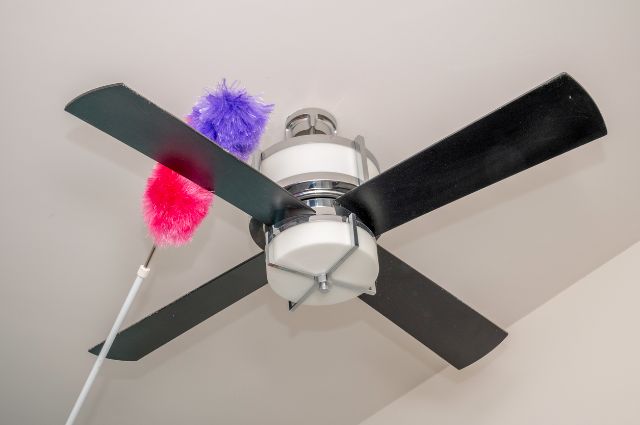
Cleaning techniques depending on the type of fan and its condition
Depending on the type of fan and its condition we will have to adapt our cleaning strategy.
How to clean ceiling fans safely
Before starting any cleaning, the first thing to do is to ensure safety. This includes turning the fan off at the switch and also disconnecting it from the electrical panel if possible. An electrical accident or a fall due to a bad maneuver is not worth saving a few minutes.
Make sure you have a stable ladder, preferably with non-slip rungs. Never use unstable chairs or furniture. Use rubber or latex gloves to protect your hands from dust and the products you use.
Once safe, start with a superficial cleaning so as not to raise too much dust. The use of a pillowcase, as already mentioned, is very practical for the blades. Afterwards, you can wipe with a damp cloth with a specific or homemade product.
Another key point is to prevent cleaning products from coming into contact with the motor or cables. If the fan has exposed electrical components, it is best not to apply any liquid directly. Instead, use a slightly damp cloth.
How to Clean Ceiling Fans with Built-in Lights
Fans with built-in lights are very common, especially in bedrooms and living rooms. However, cleaning them can be a bit more complex because of the added electrical component. Here are the recommended steps:
- Completely turn off the electrical power from the box.
- If the fan has a glass diffuser or soffit, carefully remove it. It is usually attached with clips or screws.
- Wash the glass with warm soapy water and dry it completely before replacing it.
- With a slightly damp cloth, wipe the lamp holder and the metal surround. Do not use water directly on the electrical part.
- Clean the blades as we have already seen, without wetting the motor area or the cables.
A thorough cleaning of this type of fan not only improves its appearance, but also the efficiency of lighting and airflow.
How to clean very dirty fans step by step
If you haven’t cleaned your fan in months or you’ve just moved into a home where it’s been years without maintenance, you’re in for a grim prospect: black dust, cobwebs and perhaps accumulated grease.
Not to worry. Here’s a step-by-step guide to dealing with a very dirty fan:
- Turn off the power completely.
- Protect the floor with old sheets or plastic, so you don’t make a mess.
- Vacuum the coarse dust from the blades with a handheld vacuum cleaner.
- Apply a strong mixture of vinegar, water and a little neutral soap to each blade.
- Allow the solution to work for 3-5 minutes to penetrate the grease.
- Wipe with a damp microfiber cloth, insisting where there are dry spots.
- Dry completely with another clean, dry cloth.
- Repeat the process on the ceiling and motor housing, avoiding getting the electrical part wet.
This type of thorough cleaning should be done at least once every 6 months.
Cleaning ceiling fans with and without disassembly
It is not always necessary to disassemble the fan to clean it properly, but in some cases, especially if it has internal dust accumulation or if you have not been able to clean it for a long time, it is advisable to do so.
Cleaning without disassembly
- Ideal for regular maintenance.
- Use a duster, a damp cloth and wipe every visible part.
- Be sure to clean the motor base as well.
Cleaning with disassembly
- Necessary if there is a lot of dust inside the motor or on the connections.
- Remove the blades one by one (they are usually fixed with screws).
- Thoroughly clean each part and reassemble them carefully.
- If you are unsure, consult the manual or seek professional help.
How to clean fan blades by material
Not all blades are the same. Some are made of plastic, others of wood or even metal. And each type needs special care:
- Plastic blades: easy to clean, they resist water and products well. Use a damp cloth and a little detergent.
- Wooden blades: very common in decorative fans. Use specific products for wood or a mixture of vinegar and vegetable oil to nourish the surface.
- Metal blades: usually found in industrial models. Clean with a damp cloth and dry well to avoid oxidation. Avoid acid products.
The important thing is not to damage the finish or cause deformation. Always test first in an inconspicuous corner if you use a new product.
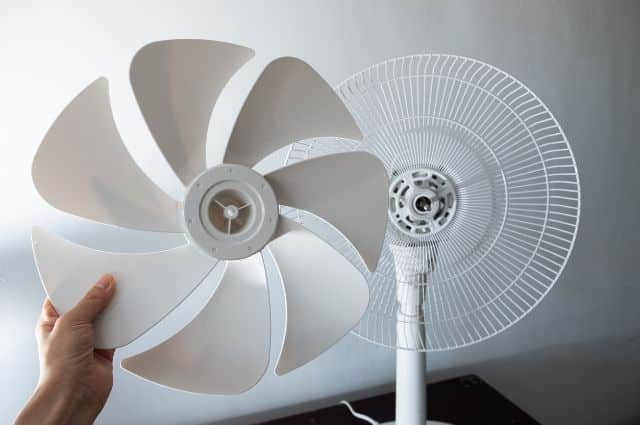
Tips for Cleaning Fans in Humid Climates
In coastal or high humidity areas, fans accumulate mold, saltpeter and moisture that deteriorate their materials. Here are some specific tips:
- Use products with antifungal properties, such as white vinegar or baking soda.
- Clean more frequently, at least twice a month.
- Dry all parts thoroughly after cleaning to avoid corrosion.
- Apply a metal or wood preservative if necessary.
- If mildew is present, do not use bleach directly, as it can be abrasive. Mix vinegar with hot water, let it act, and then remove.
This care will prevent premature aging of the fan and keep it in good condition, even in the most demanding environments.
Cleaning fans in specific spaces
Depending on where it is installed, we must pay attention to some aspects of the cleaning process.
How to Clean Ceiling Fans Installed in High Ceilings
One of the biggest challenges when it comes to cleaning are high ceilings. Here, the most important thing is safety and accessibility. Some recommended solutions:
- Use a telescopic duster if you only need to dust.
- If the cleaning is deeper, use a wide platform ladder, preferably with someone accompanying you.
- Another interesting option is the use of a domestic cleaning hoist, although it can be expensive.
In case the fan is installed at a height of more than 3 meters and the cleaning is complex, it is best to hire a professional. They have the appropriate tools to work at height without risk.
Cleaning of fans in children’s rooms: special care
In a children’s room, care must be more meticulous. Little ones are usually more sensitive to dust, odors and cleaning products. Some key tips:
- Always use natural or neutral products, such as diluted vinegar or water with mild soap.
- Avoid any artificially fragranced chemicals.
- Clean the blades more frequently, at least once every two weeks.
- If the fan has children’s decorations (stickers, paintings), clean carefully so as not to peel them off or damage them.
Also, make sure that the fan is well fastened and does not make strange noises, since a poorly adjusted fan can generate vibrations or even be dangerous if there are children nearby.
Cleaning ceiling fans in offices and workspaces
Fans in offices are often in constant operation and exposed to dust from electronic equipment, papers and carpets. This causes them to accumulate particles more quickly. Here are some tips for these environments:
- Schedule regular monthly cleanings, especially in common areas.
- Use vacuum cleaners with HEPA filters to clean the motor area without raising dust.
- Clean blades with mild disinfectants that do not leave a strong odor.
- Make sure there are no loose wires or mismatched connections after cleaning.
In these spaces it is very useful to keep a maintenance log, especially in large offices where multiple fans are installed.
How to clean industrial fans efficiently
Industrial fans, whether in warehouses, factories or workshops, require more demanding cleaning due to the accumulation of dust, grease or even chemical residues. The process usually includes:
- Complete disconnection of electrical power.
- Use of personal protective equipment: gloves, goggles, mask.
- Cleaning with specific industrial degreasers if there is grease accumulation.
- Removal of protective grids and thorough cleaning of the blades.
- Rinsing with pressurized water (if the model allows it) or steam cleaning.
Given its size, in many cases it is better to have a specialized service, especially if disassembly or cleaning of the internal motor is required.
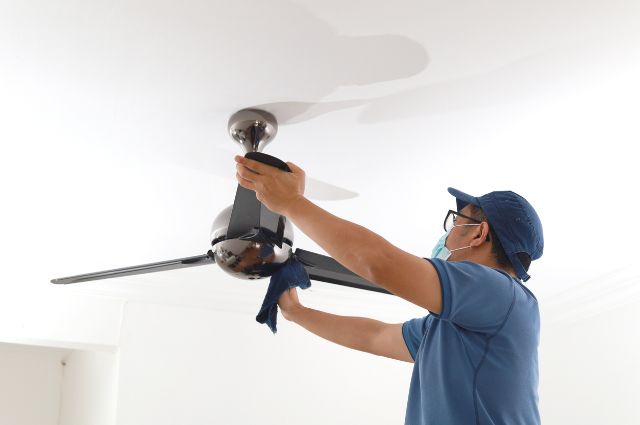
Maintenance and specialized services for fans
Sometimes we must dedicate more time to the care of our fan and perform maintenance beyond the usual cleaning. Also depending on the location, use or type of fan it may be necessary to have professional help.
Let’s look at each case in detail.
Complete ceiling fan maintenance guide
Regular maintenance of a ceiling fan includes several key tasks that ensure proper operation and prevent future problems:
- Blade and motor cleaning: dust and dirt quickly accumulate on the blades and motor, which can affect the fan’s efficiency and cause annoying noises. It is recommended to clean the blades with a soft, damp cloth, avoiding abrasive products that may damage the material. For the motor, it is better to use compressed air or a soft brush to remove dust.
- Checking screws and anchors: Over time, vibrations can loosen the screws that hold the fan to the ceiling or the blades to its structure. It is important to check and tighten all screws periodically to avoid excessive vibrations and possible falls.
- Lubrication of moving components: Some models require lubrication of the bearings or shafts to keep the fan rotating smoothly. Use specific lubricants listed in the manufacturer’s manual to avoid damage.
- Balance check: An unbalanced fan generates noise and premature wear. To correct this, balancing kits can be used to help balance the blades or adjust their position.
- Electrical check: It is essential to inspect that the electrical connections are in good condition, with no frayed wires or loose connections, to avoid short circuits or ignition problems.
When to hire professional fan cleaning services
Although many maintenance tasks can be performed independently, there are situations in which it is advisable to call in specialized professionals:
- Deep cleaning and disassembly: When the fan has dirt accumulated in hard-to-reach areas, or if it needs to be disassembled for thorough cleaning, a qualified technician ensures safe and effective handling.
- Electrical or mechanical repairs: Problems such as motor failure, strange noises, or interruptions in operation may require specialized diagnosis and repair to avoid electrical hazards or further damage.
- Installation or replacement of components: Should you need to replace blades, motors, or control systems, experts ensure proper installation in compliance with safety standards.
- Maintenance on large or industrial fans: In professional or industrial environments, where fans are larger and more complex, the intervention of specialists is essential to ensure safe and effective maintenance.
In summary, regular and careful maintenance extends the service life of ceiling fans, makes them perform optimally and helps us to avoid problems arising from the accumulation of dust and dust mites.
However, for complex tasks or when the fan fails, hiring professional services is the most advisable option both for safety and to preserve the functionality of the equipment.


